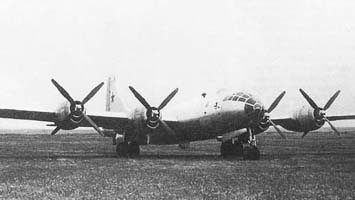-
The story of how Soviets pirated B-29 technology and built Tu-4
Теги:
Dron
втянувшийся

WASHINGTON — After bombing missions against Japanese targets in 1944, three
troubled American B-29s made emergency landings at the Soviet town of
Vladivostok in southeastern Russia. The U.S. pilots assumed that as allies, they
would be in friendly Russian hands. But they were wrong.
"They didn't realize what was going to happen to the airplanes. But when
you're on fire, you look for a place to land," said George Larson, the
editor of "Air and Space/Smithsonian Magazine."
Soviet leader Joseph Stalin eventually released the crews, but he ordered the
B-29 Superfortresses seized and copied. He put his security chief Lavrenty Beria
in charge of thousands of engineers and workers — using fear and patriotism to
drive the project. Failure could land workers in exile in Siberia.
< !-- ======= WRAPPER ======= -->
< !-- ======= /WRAPPER ======= -->
The crews dismantled one of the planes into 105,000 parts, created blueprints
and then reproduced the bomber in just two years.
"What he wanted to do was close a vulnerability to the West; to have an
intercontinental, long-range bomber equal to the B-29, which became even more
crucial after 1949 with the first Soviet atomic weapon," explained Von
Hardesty, a museum curator and specialist in Soviet air power at the Smithsonian
Museum.
It was a B-29 Superfortress, the Enola Gay, that dropped the first American
atomic bomb on Japan.
'Phenomenal feat of human engineering'
On the cutting edge of technology at the time, the B-29 had a pressurized
crew compartment, computerized defensive weapons system, and advanced radar for
bombing and navigation, Larson said.
< !--===========IMAGE============-->  < !--===========/IMAGE===========--> < !--===========/IMAGE===========--> | |
| < !--===========CAPTION==========--> Soviet engineers copied the B-29 Superfortress and renamed it the Tu-4 bomber < !--===========/CAPTION=========--> |
[/td]
[/tabtr]
[/tbody]
>
New details of how Soviet engineers copied the B-29 Superfortress and renamed
it the Tu-4 bomber were released Thursday after a 12-year investigation by the
Smithsonian Institution's National Air and Space Museum in cooperation with the
Russian government and historians.
"It's a phenomenal feat of human engineering," said Hardesty during
a panel discussion at the Russian embassy. He noted the new information was
gathered from interviews as well as from newly declassified documents.
During World War II, Russia had asked its ally, the United States, for the
B-29, under a lend-lease program. But Washington would only send Moscow
transport planes and bombers other than the B-29.
After the three B-29s landed on Soviet soil, famed aviation designer Andrei
Tupolev was put in charge of the 900 factories and research institutions ordered
to copy the planes.
"Tupolev ... had radio links out to the various factories, and they
would report almost daily on their progress. It was the equivalent of their
Manhattan Project — high priority," Hardesty said, comparing the task to
the U.S. effort to build the nuclear bomb.
Even problems were copied
One of the confiscated planes was left untouched and used as a model and a
second was used for test flights, said Maximilian Saukke, son of a Soviet
engineer on the project.
The third, Saukke told the Smithsonian panel, was disassembled.
"They took it apart component by component, panel by panel, almost rivet
by rivet," Hardesty said in an interview.
"It was measured and copied and photographed, and then someone would get
the assignment to replicate a part, like an altimeter."
He said they finished the design work in one year and produced planes in the
second.
The B-29 was copied almost exactly — warts and all. One problem the cloned
bomber shared with its U.S. source: notoriously unreliable engines.
"Our engines caught fire as well as the American ones," laughed
Vladimir Rigmant, director of the Tupolev Museum, who attended the Smithsonian
event.
< !--===========IMAGE============-->  < !--===========/IMAGE===========--> < !--===========/IMAGE===========--> | |
| < !--===========CAPTION==========--> The B-29 bomber Enola Gay dropped the first atomic bomb on Japan in 1945 < !--===========/CAPTION=========--> |
[/td]
[/tabtr]
[/tbody]
>
U.S. intelligence caught on in 1947
"The Tu-4 was a big surprise" when the West saw it flown at a 1947
Soviet air show, Hardesty said.
U.S. intelligence officials suspected soon thereafter that the Soviets
seemingly had copied the B-29. The new research, though, details how the Soviets
did it — through reverse engineering.
"We wondered how did they do this, how did they manage it, how did they
get the material and the human resources ... the discipline?" Hardesty
said.
The Soviets couldn't reproduce the U.S. planes' giant tires, so Soviet agents
were sent to buy them at military surplus sales in the West.
The Soviet Union eventually built 850 Tu-4s. One dropped a nuclear test bomb
in 1951 in territory that is now independent Kazakhstan.
U.S. officials feared the Soviet bombers could hit targets in the United
States.
"The very existence of the Tu-4 and its jet-powered successors prompted
the United States to set up an array of defensive systems, including the Nike
surface-to-air missiles and the Skysweep radar-guided anti-aircraft guns of the
1950s," Hardesty writes.
Copyright © Balancer 1997..2018
Создано 27.01.2001
Связь с владельцами и администрацией сайта: anonisimov@gmail.com, rwasp1957@yandex.ru и admin@balancer.ru.
Создано 27.01.2001
Связь с владельцами и администрацией сайта: anonisimov@gmail.com, rwasp1957@yandex.ru и admin@balancer.ru.
 Dron
Dron

 инфо
инфо инструменты
инструменты